Abstract
1. Cumulative small steps in venous congestion pressure were used to study the effect of passive tilt on vascular parameters in dependent tissues. Using this protocol we have non-invasively assessed venous pressure (Pv,est), isovolumetric cuff pressure (Pv,i), which is the congestion cuff pressure (Pcuff) that has to be exceeded to induce fluid filtration. We have also assessed microvascular filtration capacity (Kf), which is the linear relationship between filtration rate (Jv) and Pcuff, when Pcuff > Pv,i, and is the product of the available exchange vessel surface area and wall conductance. 2. Subjects were passively tilted to increase the venous pressure at the level of the calf by 47.4 +/- 2.4 mmHg (mean +/- S.E.M.). The value of Pv,i increased from 20.6 +/- 1.8 to 48.5 +/- 3.8 mmHg after the imposition of the tilt. This change may reflect the increased colloid osmotic pressure at the microvascular interface that is known to occur in response to this manoeuvre. 3. The pre-tilt value of Kf did not change after the imposition of the passive tilt, the values being 3.2 +/- 0.4 x 10(-3) and 3.6 +/- 0.4 x 10(-3) ml min-1 (100 ml-1) mmHg-1, respectively, (n = 13). 4. These results support the notion that passive postural change alters the pre-capillary resistance, thereby altering the pressure and flow characteristics within the exchange vessels, but does not alter the surface area available for fluid exchange in the calf, contrary to previous findings in the dependent human foot using a single-step venous occlusion protocol.
Full text
PDF
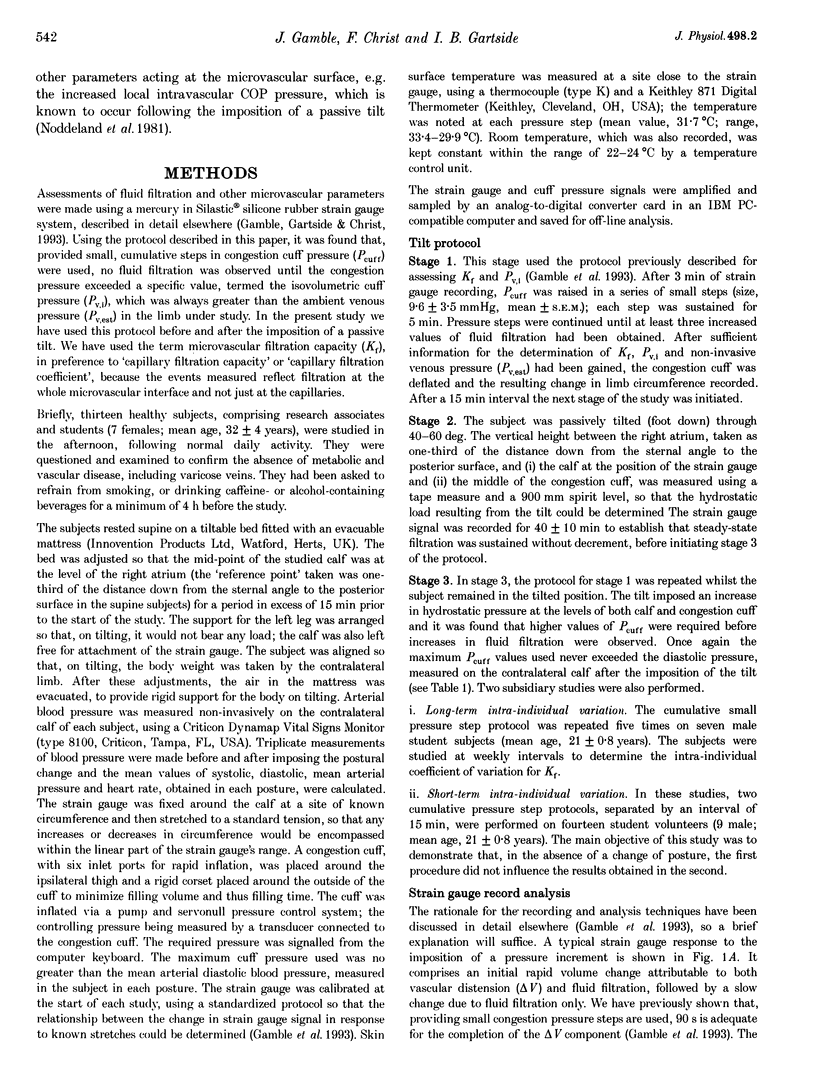
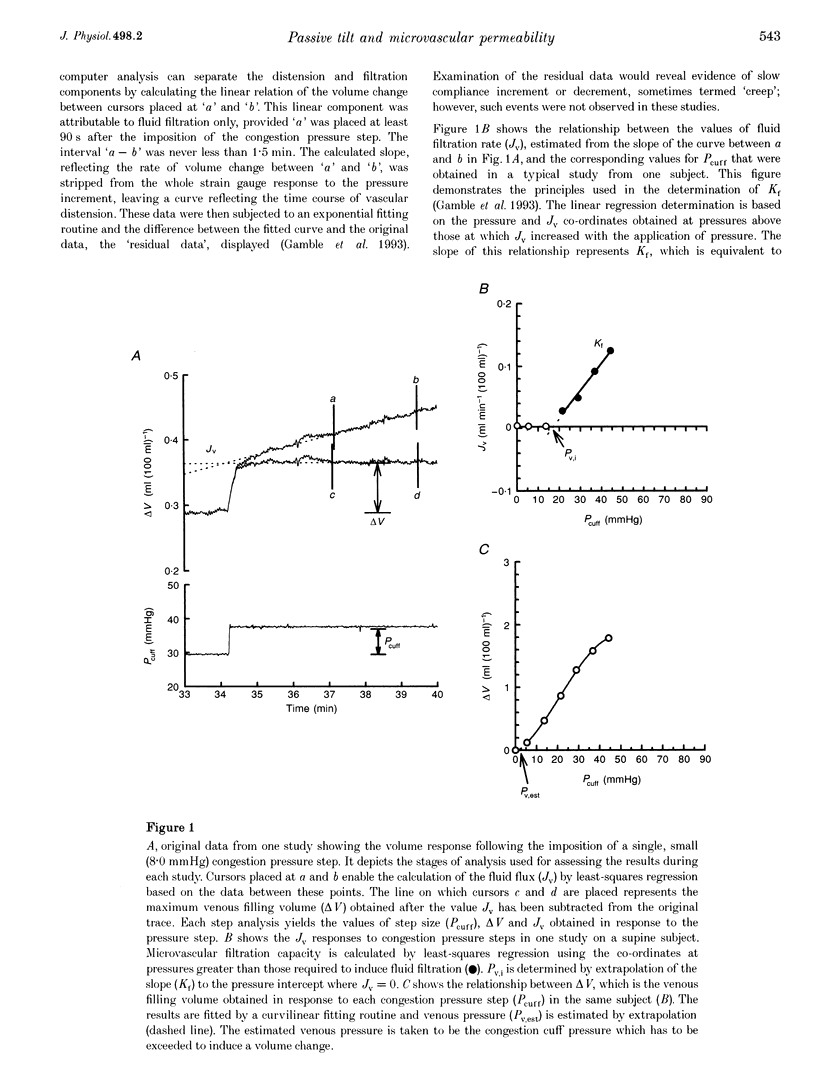
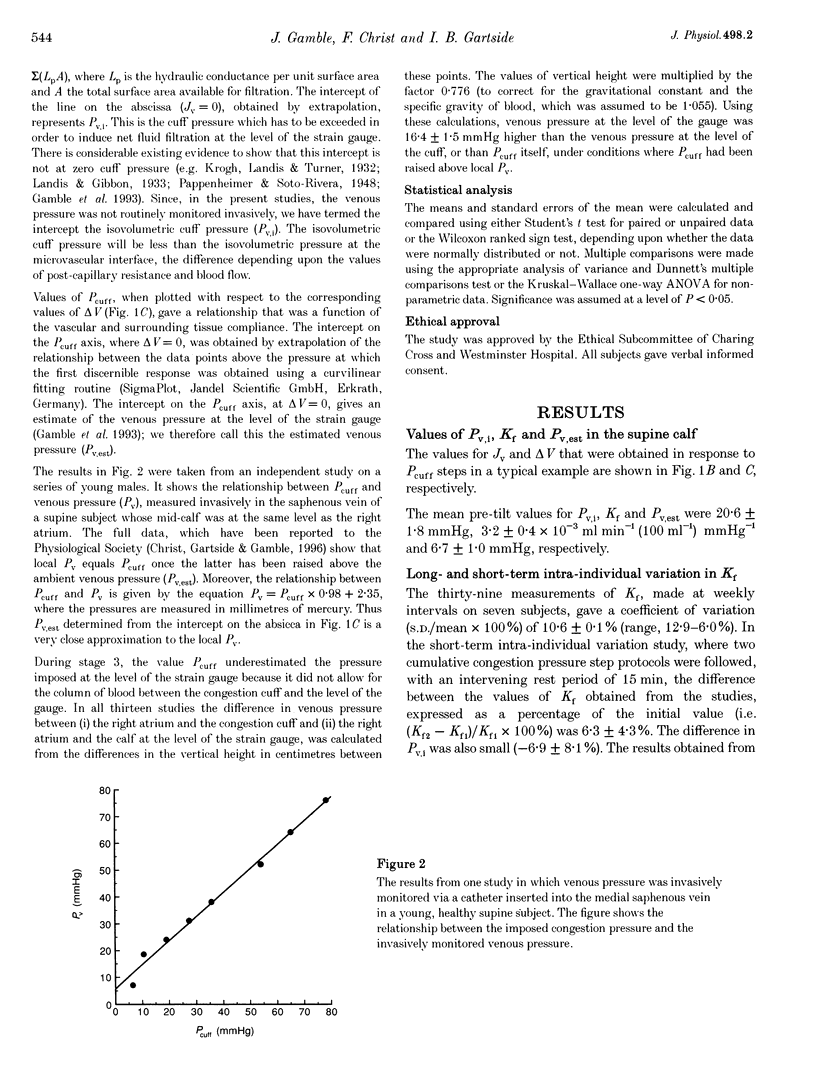

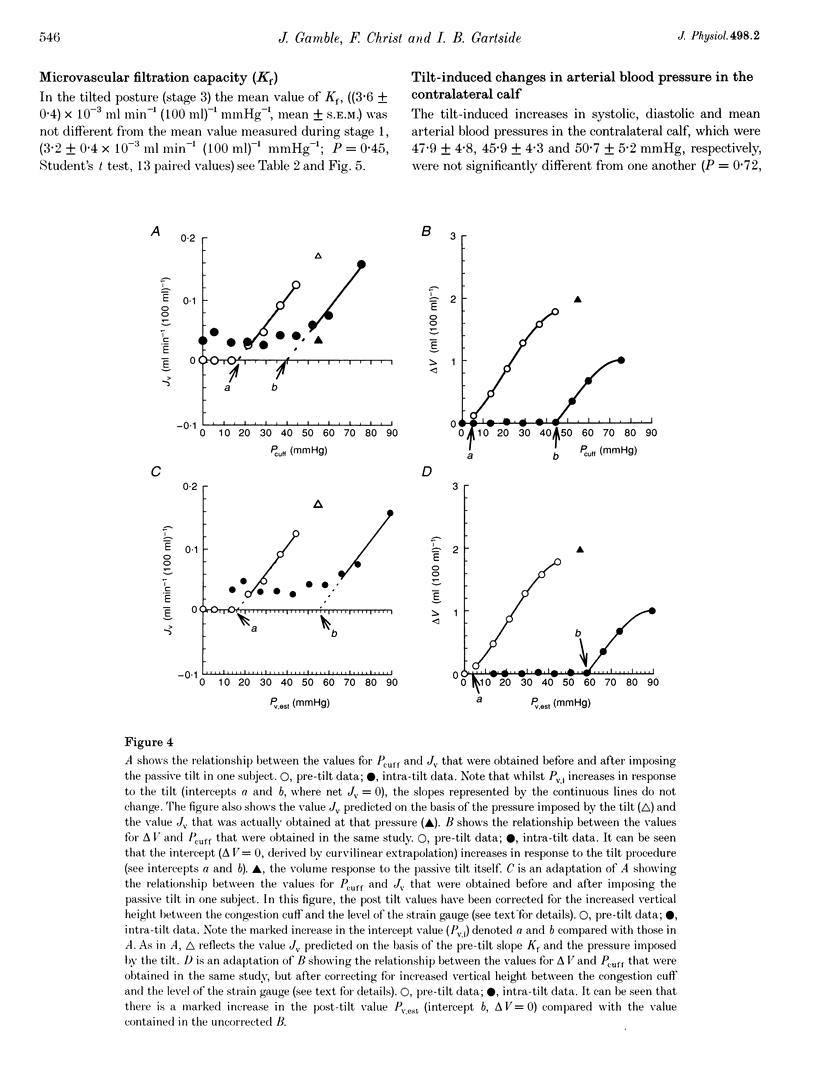

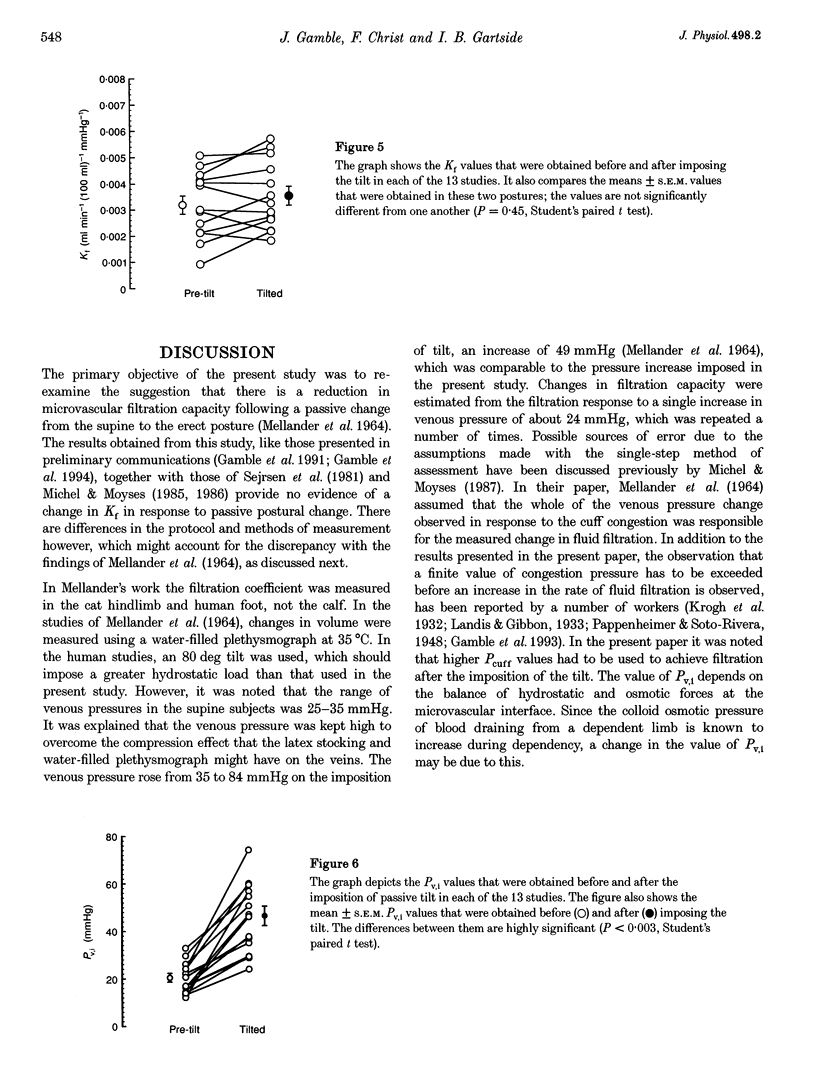
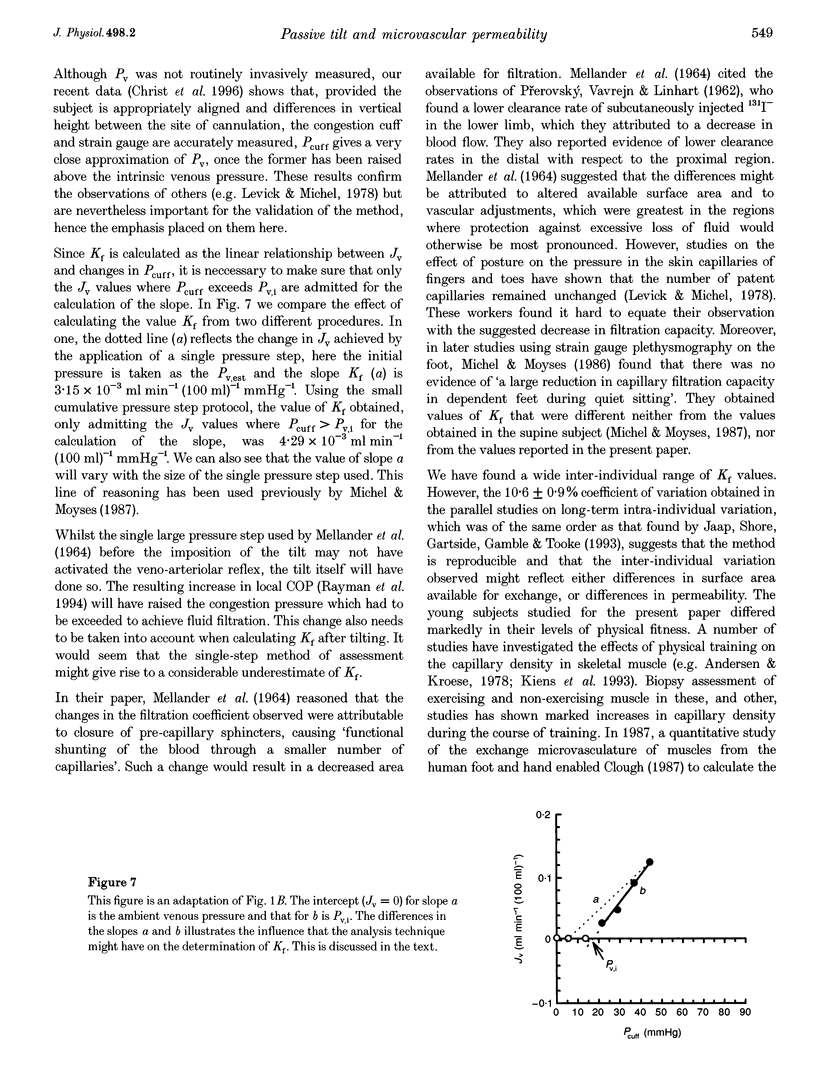
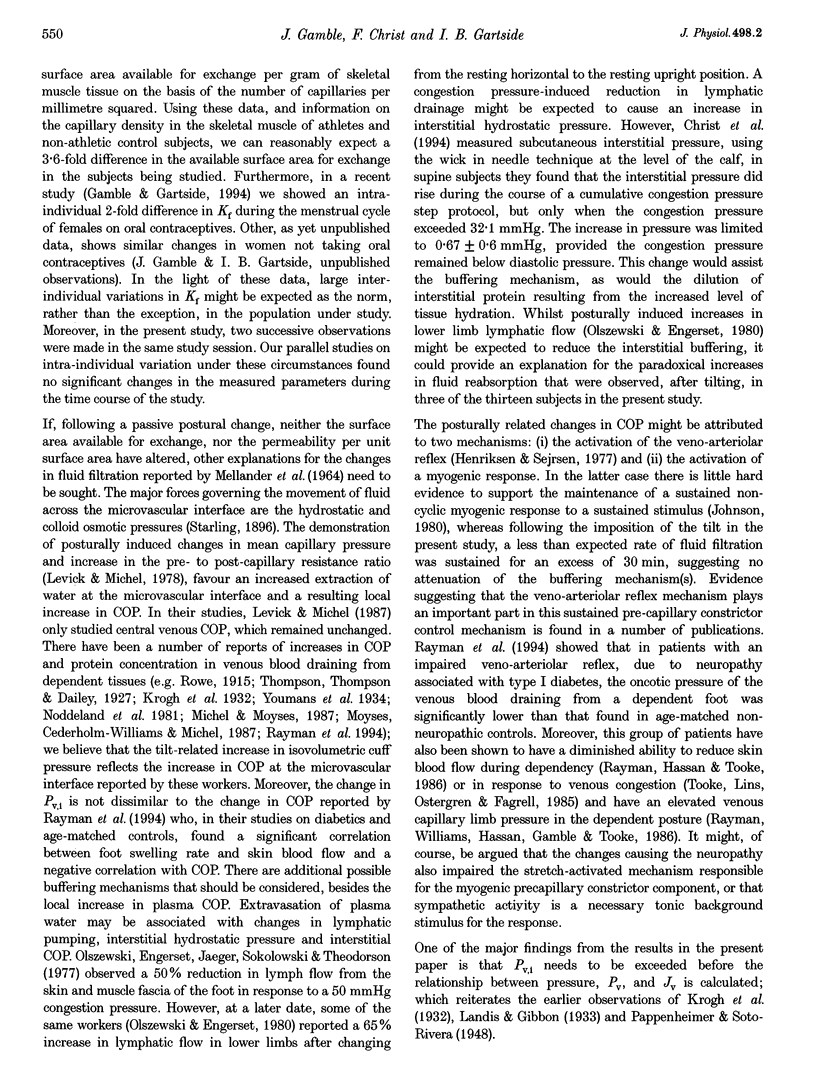
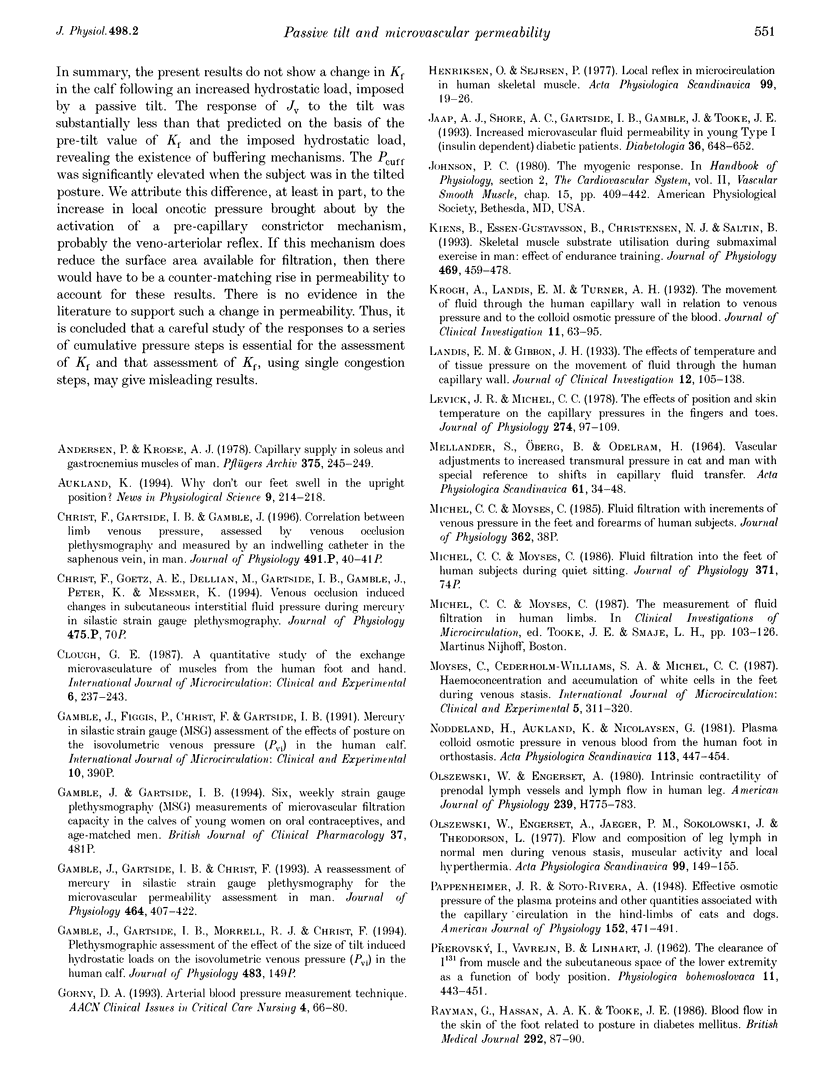
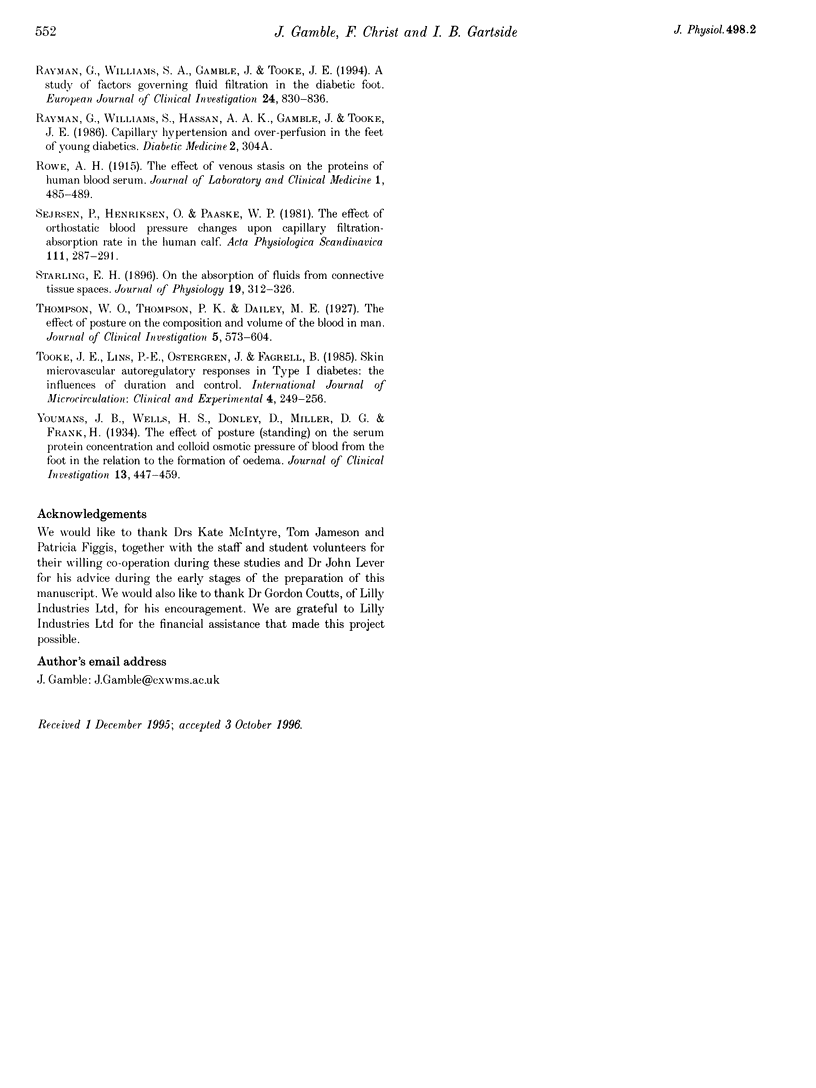
Selected References
These references are in PubMed. This may not be the complete list of references from this article.
- Andersen P., Kroese A. J. Capillary supply in soleus and gastrocnemius muscles of man. Pflugers Arch. 1978 Aug;375(3):245–249. doi: 10.1007/BF00582437. [DOI] [PubMed] [Google Scholar]
- Clough G. A quantitative study of the exchange microvasculature of muscles from the human foot and hand. Int J Microcirc Clin Exp. 1987 Aug;6(3):237–243. [PubMed] [Google Scholar]
- Gamble J., Gartside I. B., Christ F. A reassessment of mercury in silastic strain gauge plethysmography for microvascular permeability assessment in man. J Physiol. 1993 May;464:407–422. doi: 10.1113/jphysiol.1993.sp019642. [DOI] [PMC free article] [PubMed] [Google Scholar]
- Gorny D. A. Arterial blood pressure measurement technique. AACN Clin Issues Crit Care Nurs. 1993 Feb;4(1):66–80. [PubMed] [Google Scholar]
- Henriksen O., Sejrsen P. Local reflex in microcirculation in human skeletal muscle. Acta Physiol Scand. 1977 Jan;99(1):19–26. doi: 10.1111/j.1748-1716.1977.tb10347.x. [DOI] [PubMed] [Google Scholar]
- Jaap A. J., Shore A. C., Gartside I. B., Gamble J., Tooke J. E. Increased microvascular fluid permeability in young type 1 (insulin-dependent) diabetic patients. Diabetologia. 1993 Jul;36(7):648–652. doi: 10.1007/BF00404075. [DOI] [PubMed] [Google Scholar]
- Kiens B., Essen-Gustavsson B., Christensen N. J., Saltin B. Skeletal muscle substrate utilization during submaximal exercise in man: effect of endurance training. J Physiol. 1993 Sep;469:459–478. doi: 10.1113/jphysiol.1993.sp019823. [DOI] [PMC free article] [PubMed] [Google Scholar]
- Krogh A., Landis E. M., Turner A. H. THE MOVEMENT OF FLUID THROUGH THE HUMAN CAPILLARY WALL IN RELATION TO VENOUS PRESSURE AND TO THE COLLOID OSMOTIC PRESSURE OF THE BLOOD. J Clin Invest. 1932 Jan;11(1):63–95. doi: 10.1172/JCI100408. [DOI] [PMC free article] [PubMed] [Google Scholar]
- Landis E. M., Gibbon J. H. THE EFFECTS OF TEMPERATURE AND OF TISSUE PRESSURE ON THE MOVEMENT OF FLUID THROUGH THE HUMAN CAPILLARY WALL. J Clin Invest. 1933 Jan;12(1):105–138. doi: 10.1172/JCI100482. [DOI] [PMC free article] [PubMed] [Google Scholar]
- Levick J. R., Michel C. C. The effects of position and skin temperature on the capillary pressures in the fingers and toes. J Physiol. 1978 Jan;274:97–109. doi: 10.1113/jphysiol.1978.sp012136. [DOI] [PMC free article] [PubMed] [Google Scholar]
- MELLANDER S., OBERG B., ODELRAM H. VASCULAR ADJUSTMENTS TO INCREASED TRANSMURAL PRESSURE IN CAT AND MAN WITH SPECIAL REFERENCE TO SHIFTS IN CAPILLARY FLUID TRANSFER. Acta Physiol Scand. 1964 May-Jun;61:34–48. doi: 10.1111/j.1748-1716.1964.tb02940.x. [DOI] [PubMed] [Google Scholar]
- Moyses C., Cederholm-Williams S. A., Michel C. C. Haemoconcentration and accumulation of white cells in the feet during venous stasis. Int J Microcirc Clin Exp. 1987;5(4):311–320. [PubMed] [Google Scholar]
- Noddeland H., Aukland K., Nicolaysen G. Plasma colloid osmotic pressure in venous blood from the human foot in orthostasis. Acta Physiol Scand. 1981 Dec;113(4):447–454. doi: 10.1111/j.1748-1716.1981.tb06921.x. [DOI] [PubMed] [Google Scholar]
- Olszewski W. L., Engeset A. Intrinsic contractility of prenodal lymph vessels and lymph flow in human leg. Am J Physiol. 1980 Dec;239(6):H775–H783. doi: 10.1152/ajpheart.1980.239.6.H775. [DOI] [PubMed] [Google Scholar]
- Olszewski W., Engeset A., Jaeger P. M., Sokolowski J., Theodorsen L. Flow and composition of leg lymph in normal men during venous stasis, muscular activity and local hyperthermia. Acta Physiol Scand. 1977 Feb;99(2):149–155. doi: 10.1111/j.1748-1716.1977.tb10365.x. [DOI] [PubMed] [Google Scholar]
- PREROVSKY I., VAVREJN B., LINHART J. The clearance of I-131 from muscle and the subcutaneous space of the lower extremity as a function of body position. Physiol Bohemoslov. 1962;11:443–451. [PubMed] [Google Scholar]
- Rayman G., Hassan A., Tooke J. E. Blood flow in the skin of the foot related to posture in diabetes mellitus. Br Med J (Clin Res Ed) 1986 Jan 11;292(6513):87–90. doi: 10.1136/bmj.292.6513.87. [DOI] [PMC free article] [PubMed] [Google Scholar]
- Rayman G., Williams S. A., Gamble J., Tooke J. E. A study of factors governing fluid filtration in the diabetic foot. Eur J Clin Invest. 1994 Dec;24(12):830–836. doi: 10.1111/j.1365-2362.1994.tb02027.x. [DOI] [PubMed] [Google Scholar]
- Sejrsen P., Henriksen O., Paaske W. P. Effect of orthostatic blood pressure changes upon capillary filtration-absorption rate in the human calf. Acta Physiol Scand. 1981 Mar;111(3):287–291. doi: 10.1111/j.1748-1716.1981.tb06738.x. [DOI] [PubMed] [Google Scholar]
- Starling E. H. On the Absorption of Fluids from the Connective Tissue Spaces. J Physiol. 1896 May 5;19(4):312–326. doi: 10.1113/jphysiol.1896.sp000596. [DOI] [PMC free article] [PubMed] [Google Scholar]
- Thompson W. O., Thompson P. K., Dailey M. E. THE EFFECT OF POSTURE UPON THE COMPOSITION AND VOLUME OF THE BLOOD IN MAN. J Clin Invest. 1928 Jun;5(4):573–604. doi: 10.1172/JCI100179. [DOI] [PMC free article] [PubMed] [Google Scholar]
- Tooke J. E., Lins P. E., Ostergren J., Fagrell B. Skin microvascular autoregulatory responses in type I diabetes: the influence of duration and control. Int J Microcirc Clin Exp. 1985;4(3):249–256. [PubMed] [Google Scholar]
- Youmans J. B., Wells H. S., Donley D., Miller D. G., Frank H. THE EFFECT OF POSTURE (STANDING) ON THE SERUM PROTEIN CONCENTRATION AND COLLOID OSMOTIC PRESSURE OF BLOOD FROM THE FOOT IN RELATION TO THE FORMATION OF EDEMA. J Clin Invest. 1934 May;13(3):447–459. doi: 10.1172/JCI100597. [DOI] [PMC free article] [PubMed] [Google Scholar]


